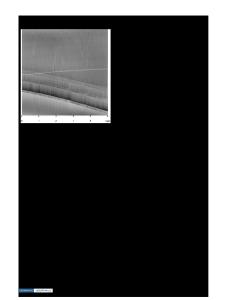Scanning Tunneling Optical Resonance Microscopy (STORM)
- PDF / 152,758 Bytes
- 7 Pages / 612 x 792 pts (letter) Page_size
- 111 Downloads / 322 Views
G3.3.1
Scanning Tunneling Optical Resonance Microscopy (STORM) R.P. Raffaelle1, T. Gennett1, J. E. Lau2, P. Jenkins2, S.L. Castro2, P. Tin3, D.M. Wilt4, A.M. Pal4, and S.G. Bailey4 1
Rochester Institute of Technology, Rochester, NY 14623 Ohio Aerospace Institute, 22800 Cedar Point Road, Cleveland, OH 44142 3 National Center for Microgravity Research, Cleveland, OH 44135 4 NASA Glenn Research Center, 21000 Brookpark Road, MS 302-1, Cleveland, OH 44135 2
ABSTRACT The ability to determine the in-situ optoelectronic behavior of semiconductor materials has become especially important as the size of device architectures is reduced and the development of complex microsystems has increased. Scanning Tunneling Optical Resonance Microscopy or STORM has the ability to interrogate the optical bandgap as a function of position within a semiconductor microstructure. This technique uses a tunable solid-state Ti sapphire laser whose output is “chopped” using a spatial light modulator and is coupled by a fiber optic to a scanning tunneling microscope in order to illuminate the tip-sample junction. The photoenhanced portion of the tunneling current is spectroscopically measured using a lockin technique. The capabilities of this technique were verified using semiconductor microstructure calibration standards that were grown by organometallic vapor phase epitaxy (OMVPE) at the NASA Glenn Research Center. Bandgaps characterized by STORM measurements were found to be in good agreement with the bulk values determined by transmission spectroscopy, photoluminescence, and with the theoretical values that were based on x-ray diffraction results. INTRODUCTION The reduction in the size of semiconductor microstructures within devices has been a common theme ever since the beginning of the microelectronics revolution. It is the “smaller” aspect of “smaller, faster, cheaper, better” mantra that has continually challenged our analytical capabilities. The more recent developments in the area of nanotechnology and nanomaterials have raised the bar even higher when it comes to in-situ materials parameters characterization. Microsystems or systems that combine microelectronics, micro-electromechanical systems (MEMS), sensors, and power devices all into a single entity that will be processed using the same sort of techniques used in the microelectronics industry today is a major focus of today’s technological community.1 It is highly likely that in the next two decades virtually all products will incorporate some sort of a microsystem. These systems will add functionality; reduce the size, weight and cost of future products. It has been predicted that the microsystems revolution will have a greater impact on our lives than the microelectronics revolution of the latter half of the 20th century. Microsystem development requires the combination of a variety of different types of materials and functionality. The ability to identify a small micron, sub-micron, or nanometer scale regions of a microsystem or device is difficult enough, let alone trying to d
Data Loading...









